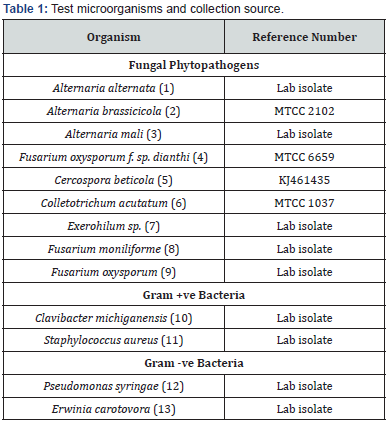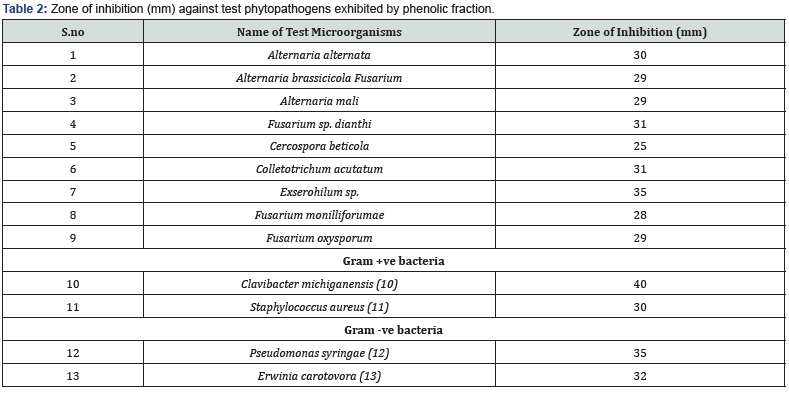Antiphytopathogenic Potential of Phenolic Compounds of Endophytic Cladosporium Velox Isolated from Tinospora Cordifolia
Bahaderjeet Singh* and Parvesh Kumar
University college of Agriculture,Guru Kashi University, Talwandi Sabo, Punjab, India
Submission: November 14, 2020;Published: December 22, 2020
*Corresponding author: University college of Agriculture,Guru Kashi University, Talwandi Sabo, Punjab, India
How to cite this article: Bahaderjeet S, Parvesh K. Antiphytopathogenic Potential of Phenolic Compounds of Endophytic Cladosporium Velox Isolated from Tinospora Cordifolia. Organic & Medicinal Chem IJ. 2020; 10(3): 555787. DOI: 10.19080/OMCIJ.2020.10.555787
Abstract
Aim of the present study to evaluate antimicrobial potential of phenolic compounds isolated from endophytic Cladosporium velox against phytopathogens. The culture C. velox used in study is an endophyte isolated from Tinospora cordifolia. The phenolic compounds were obtained after thin layer chromatography and subjected for the evaluation of antagonistic activity. The zone of inhibition against Alternaria alternata, Alternaria mali and Alternaria brassicicola was found to be 30mm, 29mm and 29mm, respectively. The phenolic fractions exhibited 31-, 28- and 29-mm zone of inhibition against Fusarium sp. Dianthi, Fusarium monilliforumae and Fusarium oxysporum. The phenolic fraction showed 40 and 30mm zone inhibition against gram +ve bacterial strains, Clavibacter michiganensis and Staphylococcus aureus, respectively. The fraction exhibited 35- and 32-mm zone inhibition against Gram -ve strains Pseudomonas syringae and Erwinia carotovora, respectively. Thus, these phenolic compounds have potential antagonistic activity against various phytopathogens and can be used as biological control agents.
Keywords: Endophyte; Phenolic compounds; Antagonistic activity; Biocontrol
Introduction
Agriculture sector plays a strategic role in the process of economic development of a country. World population is increasing at high rate and supplying enough safe and nutritious food for a growing world population poses many challenges. Agriculture sector encounter various problems which are categorized as biotic stresses (Insects, pathogens, nematodes etc.) and abiotic stresses (nutrients, water, temperature, irradiation etc.). Diseases have detrimental impact on plants and impact agriculture production. Disease outbreaks in history include Late blight of potato in Ireland (1845- 60), Downy mildew of grapes in France (1878), Coffee rusts in Ceylon (starting in 1870s) and more recent is Black rust of wheat (1916, 1935, 1953-1954).
Therefore, management of Plant diseases is essential to improve and maintain stability of agriculture production. Chemical based pesticides which are widely used in plant disease management provide quick and direct gain in plant diseases management, but they cause numerous problems as environmental pollution, food residue effects, pest resistance and effect on non-target organisms etc. Among less hazardous options of controlling plant diseases, biological control using microorganisms has been found more feasible option. Biological control using endophytes have raised special attention. Endophytic bacteria and actinomycetes have been largely exploited because of their potential to produce bioactive compounds such as antibiotics and lytic enzymes [1-3].
Endophytes provide a broad variety of bioactive secondary metabolites with unique structure, including alkaloids, flavonoids, phenolic acids, quinones, steroids, terpenoids, tetralones, xanthones, and others possesin various biological activities of antimicrobial, antioxidant, anticancer and anti-HIV [4-6]. Phenolic acids, flavonoids etc. usually possess antibacterial and antifungal effects [6]. Several Phenolic compounds also reported in literature for their antimicrobial activities [3]. Tinospora cordifolia, has a long history of use in India as a medicine. It is reported to possess antioxidant, anti-diabetic, antimicrobial, anti-spasmodic, anti-inflammatory activities [7]. The objective of the present study was to evaluate antimicrobial activity of phenolic compounds produced by endophyte C. velox isolated from T. cordifolia, identification of phenolic compounds and to strengthen the idea that endophyte associated with plant can give similar kind of activities as their host possesses.
Material and Methods
An endophytic Cladosporium velox (MTCC 12032) exhibiting alpha glucosidase inhibitory activity isolated from T. cordifolia in our laboratory was used in the present study [8]. Production of the culture was carried out in Erlenmeyer flasks (250ml) containing 50ml of liquid production medium (malt extract 20g/l, dextrose 20g/l, peptone 1g/l) inoculated with one plug (8mm diameter) taken from periphery of the actively growing culture. The flasks were incubated at 250 rpm on a rotary shaker at 30˚C for 10 days. Thereafter, the culture broth along with the fungal biomass was extracted with 50ml of ethyl acetate under shaking conditions at 120 rpm and 40oC for 2h. The upper organic phase thus obtained was separated and concentrated on rotary evaporator (BUCHI). The concentrated samples were then re-suspended in 1 ml of HPLC grade water for further studies. The concentrated ethyl acetate extract was loaded onto a silica gel (60-120 mesh size) column (2×25.0cm). The column was eluted with 270ml of chloroform: methanol: formaldehyde (8.5:1:0.). Subsequently, the same column was subjected to elution with ethyl acetate: methanol (60:40) and fraction nos. 22-25 (15ml each) exhibiting antioxidant activity and showing similar TLC profile were pooled and selected for further studies.
i. The phenolic fraction was subjected to evaluate its antifungal activity against test phytopathogens viz. Alternaria alternata,
ii. Alternaria brassicicola,
iii. Alternaria mali,
iv. Fusarium sp. dianthi,
v. Cercospora beticola,
vi. colletotrichum cutatum,
vii. Exserohilum sp.,
viii. Fusarium monilliforumae,
ix. Fusarium oxysporum,
x. Antibacterial activity was also tested against gram +ve [(Streptococcus epidermidis,
xi. Staphylococcus aeureus,
xii. Enterococcus sp.,
xiii. Bacillus subtilis)] and
xiv. gram –ve bacteria [(Pseudomonas aeuroginosa)]
xv. Esherchia coli.
Some of the phytopathogens were isolated in the while some were obtained from microbial culture collection centre, IMTECH Chandigarh. The MTCC numbers of and source of remaining phytopathogens is mentioned in the Table 1. The partially purified fraction was analyzed for their antimicrobial potential against various fungi and bacteria. The PDA plates seeded with test fungi (100μl of 105 spores/ml) and bacteria (105 cells/ml) were punctured with sterile cork borer to make wells of 6 mm in size. After addition of 100μl (1mg/ml) partially purified fraction to each well, the plates were kept in refrigerator for 1h for diffusion of active metabolites. The plates were then incubated at 28°C for 72h and results were observed in terms of inhibition zones around the wells [9].

Results and Discussion
Results of antagonistic activity of partially purified fraction are represented in Table 2. It can be inferred from the table that Fraction showed significant activity against various tested fungal strains. The zone of inhibition against Alternaria alternata, Alternaria mali and Alternaria brassicicola was found to be 30mm, 29mm and 29mm, respectively. Alternaria alternata causal organism of Fruit rot of chilli while Alternaria brassicicola and Alternaria mali are causal organisms of Alternaria leaf spot of cabbage. The antagonistic activity against Colletotrichum acutatum was found to be significantly higher, 31mm of zone of inhibition was obtained against the pathogen which is major causal agent of fruit rot and antharcnose in various fruit crops. The phenolic fractions exhibited 31-, 28- and 29-mm zone of inhibition against Fusarium sp. Dianthi, Fusarium monilliforumae and Fusarium oxysporum, Fusarium species are known to cause various plant diseases such as fusarium wilt, rot etc. and responsible to produce mycotoxins in harvested crops. The fungus Exserohilum reported to cause leaf spot and blight in various crops, and the phenolic fraction showed highest inhibition of 35mm against Exserohilum sp.


The phenolic fraction obtained from C. velox not only showed activity against various fungal pathogen but also equally effective to control various bacterial pathogens. Clavibacter michiganensis is known to cause interveinal chlorosis and curling of leaves, wilting of foliage, and decay in tubers (agrios) and Staphylococcus aureus usually a human pathogen but it is also able to alter defence response in plants (balakrishnan). The phenolic fraction showed 40 and 30mm zone inhibition against gram +ve bacterial strains, Clavibacter michiganensis and Staphylococcus aureus, respectively. Gram +ve bacterial pathogens were small as compare to Gram -ve bacterial pathogen therefore the activity of phenolic fraction was also tested against Gram -ve bacterial strains to study the broadspectrum activity [10]. The fraction exhibited 35- and 32-mm zone inhibition against Gram –ve strains Pseudomonas syringae and Erwinia carotovora, respectively. The zone of inhibition is of all microbes is clearly visible in Figure 1.
Conclusion
In vitro bioassay demonstrated broad spectrum antimicrobial activity of partially fraction. It showed very high antagonism against all fungal phytopathogens and both Gram +ve and Gram -ve bacteria, giving inhibition zones in the range of 25-40mm.
References
- Singh M, Kumar A, Singh R, Pandey K D (2017) Endophytic bacteria: a new source of bioactive compounds. 3 Biotech 7(5): 315.
- Rafi I, Cheah Y K (2018) Bacterial Endophytes A Reservoir of Bioactive Anti-microbial Compounds. Life Sciences, Medicine and Biomedicine 2(1): 8.
- Girao M, Riberio I, Riberio T, Azevedo I C, Pereira F, et al. (2019) Actinobacteria Isolated from Laminaria ochroleuca: A Source of New ioactive Compounds. Front Microbiol 10:683.
- Guo B, Dai J, Ng S, Huang Y, Leong C, et al. (2000) Cytonic acids A and B: novel tridepside inhibitors of hCMV protease from the endophytic fungus Cytonaema species. J Nat Prod 63: 602-604.
- Strobel G, Yang X, Sears J, Kramer R, Sidhu R S, et al. (1996) Taxol fromPestalotiopsismicrospora, an endophytic fungus of Taxus wallichiana. Microbiology 142: 435-440.
- Singh H, Dixit S, Verma P C, Singh P K (2014) Evaluation of total phenolic compounds and insecticidal and antioxidant activities of tomato hairy root extract. J Agric Food Chem 62: 2588-2594.
- Singh S S, Pandey S C, Srivastava S, Gupta V S, Patro B, et al. (2003) Chemistry and medicinal properties of Tinospora Cordifolia (Guduchi). Ind J Pharm 35: 83-91.
- Singh B, Kaur T, Kaur S, Manhas R K, Kaur A (2015) An alpha-glucosidase inhibitor from an endophytic Cladosporium s with potential as a biocontrol agent. Appl Biochem Biotechnol 175: 2020-2034.
- Govindappa M R, Channabasava R, Kumar K R S, Pushpalatha K C (2013) Antioxidant activity and phytochemical screening of crude endophytes extracts of Tabebuia argentea & K. Sch. Amer J Plant Sci 4: 1641-1652.
- Rekha D, Shivanna M B (2014)Diversity, antimicrobial and antioxidant activities of fungal endophytes in Cynodondactylon(L.) Pers. and Dactylocteniumaegyptium(L.) P. Beauv. IntJCurrMicrobiolAppSci3(8): 573-591.






























